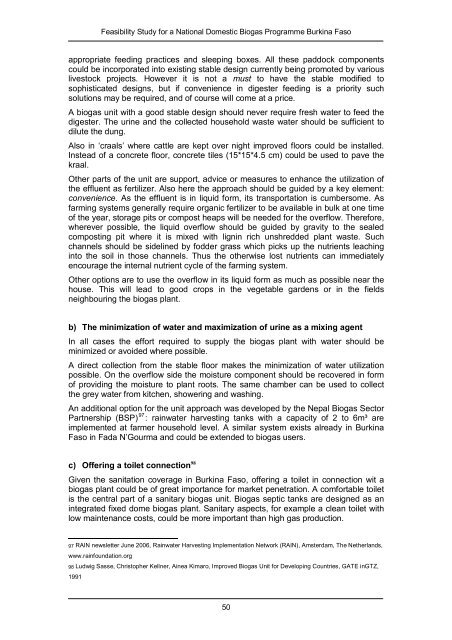Feasibility Study for a National Domestic Biogas Programme in - SNV
Feasibility Study for a National Domestic Biogas Programme in - SNV
Feasibility Study for a National Domestic Biogas Programme in - SNV
Create successful ePaper yourself
Turn your PDF publications into a flip-book with our unique Google optimized e-Paper software.
<strong>Feasibility</strong> <strong>Study</strong> <strong>for</strong> a <strong>National</strong> <strong>Domestic</strong> <strong>Biogas</strong> <strong>Programme</strong> Burk<strong>in</strong>a Faso<br />
appropriate feed<strong>in</strong>g practices and sleep<strong>in</strong>g boxes. All these paddock components<br />
could be <strong>in</strong>corporated <strong>in</strong>to exist<strong>in</strong>g stable design currently be<strong>in</strong>g promoted by various<br />
livestock projects. However it is not a must to have the stable modified to<br />
sophisticated designs, but if convenience <strong>in</strong> digester feed<strong>in</strong>g is a priority such<br />
solutions may be required, and of course will come at a price.<br />
A biogas unit with a good stable design should never require fresh water to feed the<br />
digester. The ur<strong>in</strong>e and the collected household waste water should be sufficient to<br />
dilute the dung.<br />
Also <strong>in</strong> ‘craals’ where cattle are kept over night improved floors could be <strong>in</strong>stalled.<br />
Instead of a concrete floor, concrete tiles (15*15*4.5 cm) could be used to pave the<br />
kraal.<br />
Other parts of the unit are support, advice or measures to enhance the utilization of<br />
the effluent as fertilizer. Also here the approach should be guided by a key element:<br />
convenience. As the effluent is <strong>in</strong> liquid <strong>for</strong>m, its transportation is cumbersome. As<br />
farm<strong>in</strong>g systems generally require organic fertilizer to be available <strong>in</strong> bulk at one time<br />
of the year, storage pits or compost heaps will be needed <strong>for</strong> the overflow. There<strong>for</strong>e,<br />
wherever possible, the liquid overflow should be guided by gravity to the sealed<br />
compost<strong>in</strong>g pit where it is mixed with lign<strong>in</strong> rich unshredded plant waste. Such<br />
channels should be sidel<strong>in</strong>ed by fodder grass which picks up the nutrients leach<strong>in</strong>g<br />
<strong>in</strong>to the soil <strong>in</strong> those channels. Thus the otherwise lost nutrients can immediately<br />
encourage the <strong>in</strong>ternal nutrient cycle of the farm<strong>in</strong>g system.<br />
Other options are to use the overflow <strong>in</strong> its liquid <strong>for</strong>m as much as possible near the<br />
house. This will lead to good crops <strong>in</strong> the vegetable gardens or <strong>in</strong> the fields<br />
neighbour<strong>in</strong>g the biogas plant.<br />
b) The m<strong>in</strong>imization of water and maximization of ur<strong>in</strong>e as a mix<strong>in</strong>g agent<br />
In all cases the ef<strong>for</strong>t required to supply the biogas plant with water should be<br />
m<strong>in</strong>imized or avoided where possible.<br />
A direct collection from the stable floor makes the m<strong>in</strong>imization of water utilization<br />
possible. On the overflow side the moisture component should be recovered <strong>in</strong> <strong>for</strong>m<br />
of provid<strong>in</strong>g the moisture to plant roots. The same chamber can be used to collect<br />
the grey water from kitchen, shower<strong>in</strong>g and wash<strong>in</strong>g.<br />
An additional option <strong>for</strong> the unit approach was developed by the Nepal <strong>Biogas</strong> Sector<br />
Partnership (BSP) 97 : ra<strong>in</strong>water harvest<strong>in</strong>g tanks with a capacity of 2 to 6m³ are<br />
implemented at farmer household level. A similar system exists already <strong>in</strong> Burk<strong>in</strong>a<br />
Faso <strong>in</strong> Fada N’Gourma and could be extended to biogas users.<br />
c) Offer<strong>in</strong>g a toilet connection 98<br />
Given the sanitation coverage <strong>in</strong> Burk<strong>in</strong>a Faso, offer<strong>in</strong>g a toilet <strong>in</strong> connection wit a<br />
biogas plant could be of great importance <strong>for</strong> market penetration. A com<strong>for</strong>table toilet<br />
is the central part of a sanitary biogas unit. <strong>Biogas</strong> septic tanks are designed as an<br />
<strong>in</strong>tegrated fixed dome biogas plant. Sanitary aspects, <strong>for</strong> example a clean toilet with<br />
low ma<strong>in</strong>tenance costs, could be more important than high gas production.<br />
97 RAIN newsletter June 2006, Ra<strong>in</strong>water Harvest<strong>in</strong>g Implementation Network (RAIN), Amsterdam, The Netherlands,<br />
www.ra<strong>in</strong>foundation.org<br />
98 Ludwig Sasse, Christopher Kellner, A<strong>in</strong>ea Kimaro, Improved <strong>Biogas</strong> Unit <strong>for</strong> Develop<strong>in</strong>g Countries, GATE <strong>in</strong>GTZ,<br />
1991<br />
50

















